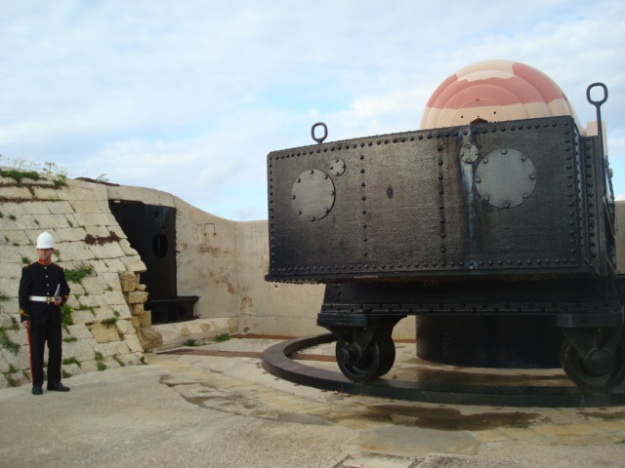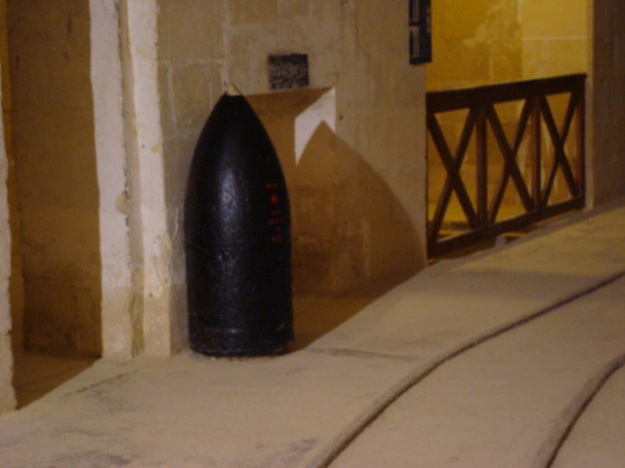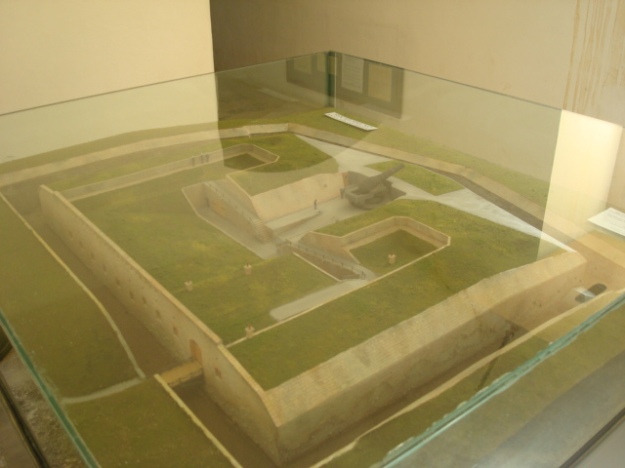Fort Rinella on Malta is the world´s first fully mechanised fort and housed only a single weapon, a 100 tonnes Armstrong gun, one of the most powerful muzzle loading gun ever built. The reason for building this monstrosity were developments in naval technology that prompted the British to build bigger in order to secure the Empire trade with India.
Brief History of Malta
To understand why the construction took place, it may be important to understand why Malta is so important. While a small group of islands, Malta is strategically located and houses natural harbours ideal for naval base and for controlling the trade in the Mediteranean Sea. Multiple cultures have tried to control the islands over time. There are remains of cultures from around 5200 BC but the first major power to establish itself on the islands were the Phoenicians who refered to it as Maleth meaning safe haven and which is where the islands take their name. Phoeniecian influence may explain the tradition of painting eyes on fishing boats on Malta for good luck and safety. Later Carthage established trading posts on the islands leading to a bilingual culture which allowed us to be able to read Phoenician from Greek based on a dual inscription on the Cippus stone found on Malta containing both Phoenician and Greek inscriptions. Following the Second Punic War the Romans moved in displacing the Carthagenians and from there it passed to Byzantium in 533 AD. It was conquered by the Arabs in the 9th century until 1091 when Norman crusaders recognised the importance and added it to their Sicilian pocessions. Eventually Malta passed to the Spanish kingdom and was granted as a gift by the Spanish king to the Knightly Order of Saint John as a base for naval operations against the Turks. Although invaded in what became known as the Great Siege in 1565 the knights held on to the island but as the order lost its reasons to exist with a more peaceful co-existence with the Ottomans, its power waned and it became unpopular with the local population. In 1798 Napoleon’s expedition to Egypt stopped over and insisted and resupply. When the knights refused the island was invaded and came under French rule. It was however short lived. Napoleon left a garrision on the island and left for Egypt with the main army and while the French had initially been greeted as liberators the mood swung and instead the garrison came under siege from the local population. While able to force the garrison to hole up in the capital victory was not achieved and the rebels approached the British navy for assistance. Following a naval blockade the French capitulated and the British seized the islands. Although by international treaties requested to leave the island, the British stayed as a protection against French aggressions and although periods of peace did exist Napoleon continued to be a threat and the islands remained garrisoned. Following the end of the Napoleonic Wars Malta had become a permanent British outpost and integrated in the Empire. This was however not considered an important part of the Empire until 1869 when the Suez Canal opened and trade suddenly took new routes.British wanted to protect their lines of communication with the Empire made Malta into a permanent naval base. Grand Harbour became HQ of the British Mediterrainan fleet as the largest natural harbour.
Why Fort Rinella?
The big question is why was it necesary to put the world’s biggest gun on Malta? To understand this we need to go back to developments in warships in the 19th century, see for instance: https://playinghistory.wordpress.com/2015/12/20/hms-warrior-1860/
But more importantly is the Battle of Lissa in 1866 where an outnumbered Austrian fleet managed to beat an Italian fleet. Following this humiliating defeat Italian navy looked into new technology to restore their navy especially in fully turreted iron ships. This because the new Caio Duilio class which was full iron hulled rather than iron clad over wood and boasted 22 inches of steel for protection and 450 mm muzzled loaded rifled guns totally automated by steam hydraulic. The British navy had nothing to match this with and likely the smaller British naval guns would be rather ineffective against these heavily armoured ships so a naval arms race ensued. In the meantime coastal fortifications were surveyed in Malta and Gibraltar and it was found that the Italian ships could outrange all coastal batteries of the two fortresses so coastal fortifications had to be modernized.

Mechanical Marvel
It was decided to upgun the forts of Malta with 100 tonnes Armstrong guns. Fort Saint Elmo was the proposed sight for the heavy naval guns being the centre of the entrance of Grand Harbour but demands for cost savings reduced to 2 guns from 4 guns and these were instead put on the flanks instead to provide crossfire across the Harbour entrance. Two bew forts were built Cambridge to the West and Rinella to the East.
It took 7 years to construct Rinella and it needed to take in all new technology available. When it was completed in 1886 it was quite a technological marvel.
Low in the ground to make it hard to spot and protect against the naval fire. Vegetation was encouraged to grow on top of the fort for better camoflage and each floor was constructed in concrete as a barreled vault to maximize protection against hits.
The gun was loaded and rammed entirely by steam power and it had two separate gun loading casemates with long rammers to ensure an awesome rate of fire of 1 shell every 6 minutes in contrast to the Italian navy who could manage only 1 shot every 20 minutes with similar guns at sea. The gun would after it was fired be rotated to either left or right casemate where the rammer would be ready to load a 450 kg gun powder charge and a 1 ton shell, after firing it would be rotated to the other casemate which by then would be ready to load. The 9 m barrel had a diameter of 450 mm and could fire 3 types of ammunition: explosive shell, penetration solid shot for punching through hulls, cased shot against smaller vessels with a range of 8 miles.
It took 3 hours to heat steam enough to run the process and 36 crew for operating the gun.

Land Defences
While the fort protected the harbour it was also important to protect the fort from the land side in case of enemy landings around the island to capture the fort and for its defence 100 infantry men were attached to the fort which was also equipped with a dry ditch and counter scarp and bent entry to gate to prevent direct fire and attack. The gate was further strengthened with a draw bridge, a so-called Guthrie bridge, that retracts into the fort and sits behind the gate for protection.
Service History
The gun was never fired in anger and was in fact not fired very often. Because a single shell cost as much as the daily wage of 2400 soldiers, practice firing of the gun was limited to one shot every 3 months. Furthermore it was estimated that 120 rounds would wear out the rifling in the gun and it wass which was unrealistic to ship back to England for refurbishing.
It was fired for the last time on 5 May 1905, and was withdrawn from active service in 1906. The gun was in active service for only 20 years and was superceded by breech loaders something that had already been in existence at the time of its installation.
Navy kept the fort as storage facility during WWII and the fortress received 7 bomb hits from planes but all of them failed to penetrate the vaults.
Visiting the Fort
The Cambridge fort is unfortunately gone but Fort Rinella is an active living history site and a very good one at that. I highly recommend a visit if visting Malta. See http://www.wirtartna.org/museums–attractions.html

